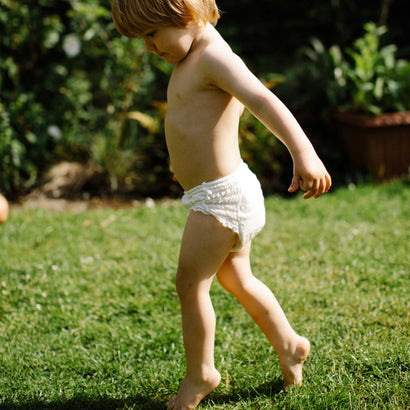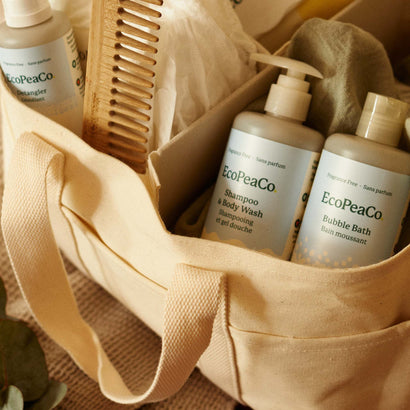There’s a lot of talk about “going green,” but is it really worth the time and money? In short, yes. The pursuit of phasing out toxins from your home can improve the mental and physical health of your family, allowing you all to live more vibrant lives. One of the prime benefits of swapping standard cleaning supplies, food, and other materials in your house for “greener” alternatives is that it reduces your toxic load.
What’s a “toxic load” you ask? This phrase refers to the build-up of toxins and chemicals in the body as it’s exposed to materials found in the environment, food, water, cleaning supplies, beauty products, and even furniture. Specifically, going outside on days when air quality is low, consuming non-organic food and storing that food in plastic containers, drinking unfiltered water, and using items like diapers that contain a variety of chemicals could expose your family to toxins like carbon monoxide, sulfur dioxide, pesticides, antibiotics, lead, arsenic, radium, chlorine, and more.
In addition, many cleaning products, carpets, paints, plastic toys, and beauty products could expose you to BPA, VOCs (volatile organic compounds), petroleum, parabens, propylene glycol, and other potentially harmful toxins.
These toxins can be especially harmful to children, as they tend to spend more time on the floor and often put more items in their mouths. And, their smaller bodies are more vulnerable to the effects of toxins. These effects could include respiratory issues, allergic reactions, and a higher risk of cancer, autism, neurocognitive disorders, mental health issues, and autoimmune diseases like Crohn's, colitis, arthritis, and lupus.
While it’s impossible to completely eliminate your family’s exposure to toxins, there are ways you can make shifts in your home to enhance your health.
Tips for helping your family live a greener life:
Buy local, organic food as often as possible. Opting for organic foods purchased at a local farmer’s market can help to ensure you’re feeding your family food that is free of chemicals and rich in nutrients. The pesticides often used on non-organic produce can increase the risk of cancer, and might impact the immune and nervous systems. Regarding the importance of buying locally, when produce has to be shipped over a significant distance, it’s often picked before it’s ripe, which could limit the amount of nutrients the produce contains by the time it reaches your plate.
Not using baby food that’s stored in plastic containers. As it’s possible for harmful chemicals like BPAs and phthalates to leach out of plastic and into baby food, it’s best to purchase baby food stored in glass containers. You can also make your own baby food and store it in glass storage containers, or silicone ice cube trays.
Only drink filtered water. Installing a filter on the tap in your kitchen, or using a stand-alone filter, can remove toxins like pharmaceuticals, pesticides, VOCs, perfluorinated chemicals (PFCs), lead, mercury, and disease-carrying pathogens from your water.
Switch to green cleaning and yard products. Improve the air your family breathes by buying cleaning products that don’t contain ammonia, phthalates, ethylene glycol, monobutyl acetate, Perchloroethylene (PERC), triclosan, 2-Butoxyethanol, chlorine, sodium hypochlorite, and trisodium phosphate. Labels such as EcoLogo, Leaping Bunny, Green Seal, and EcoCert indicate that a product is “green.”
In addition to improving the air quality in your home, consider how you can improve the air quality in your yard. A great way to do this is by swapping chemical fertilizers for safer alternatives like bone meal, cottonseed meal, alfalfa pellets, or composted manure.
Stay inside on days when the air quality is low, and use air filters. Speaking of air quality, it’s best to stay indoors as much as possible on days when air quality is poor. You can find information on the air quality index in your area at aqicn.org/map/canada/
And to stave off the lingering toxins floating around the air in your home, you can use air filters in each bedroom, and purchase air purifying plants like English Ivy, Spider Plant, or Snake Plant.
Phase out beauty products that contain toxins. Sadly, common products used for children, like baby lotion, shampoo, and sunscreen, can be filled with toxins. To learn how to avoid products with potentially harmful ingredients, check out our post on How to Avoid Harmful Ingredients in Baby Products.
Swap plastic toys for wooden alternatives. As plastic toys can expose children to chemicals like BPA and PVC, it’s best to opt for wooden toys when possible. BPA, bisphenol A, is a chemical the Food And Drug Administration has found to be hazardous to fetuses and children, and PVC, polyvinyl chloride, can be harmful because phthalates must be added to soften it. Phthalates are a potential hormone disruptor that can end up in the bloodstream and cause developmental and reproductive toxicity.
In addition to containing these ingredients, many plastic toys are cheaply made, making it easier for pieces to break off. These pieces can result in choking hazards or sharp edges.
Well-made wooden toys, on the other hand, are free of chemicals like BPA, PVC, and phthalates, and are typically much sturdier, meaning they’re less likely to result in choking or injury. See our blog post for more.
Switching to cleaner diapers. Did you know that diapers can be chock-full of toxins? That’s right, ingredients like dioxins, VOCs, synthetic fragrances, and more can live in diapers. The best solution is to select diapers, like those offered by Eco Pea, that are hypoallergenic, dermatologist tested, fragrance-free, totally chlorine free, and designed specifically for sensitive skin.
Choose non-toxic materials when buying new furniture, or updating your home. As furniture, carpet, and paint can contain toxins like formaldehyde, acetaldehyde, benzene, ethylbenzene, acetone, toluene, styrene, methylene chloride, and many others, it’s ideal to choose green options when improving your home. You can do this by selecting furniture that wasn’t treated with chemical flame retardant, is made with solid wood instead of particle board or plywood, and does not include synthetic latex. For carpet, choose an option that’s made of an organic fiber like (undyed) wool, sisal, or jute, and is “zero-VOC.” When purchasing paint, select a brand that’s “zero-VOC.”
If you’re feeling a little overwhelmed by this all information, fear not. You don’t need to go green all at once. Just start by selecting one shift you can make in your home that will help reduce the amount of chemicals your family is exposed to. When you feel firmly rooted in that first change, tackle the next on your list. Before you know it, you will have made significant steps to creating a “greener,” healthier environment for your family. And be sure to pat yourself on the back along the way, as what you’re doing isn’t easy, but well worth the effort.









